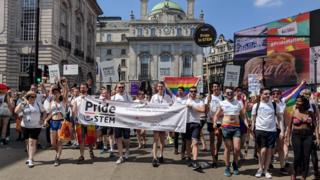LGBT+ scientists affected by discrimination

 Image copyright Christopher Carpineti/Pride in STEM
Image copyright Christopher Carpineti/Pride in STEM A report has found that 28% of LGBT+ people working in the physical sciences have considered leaving their jobs due to discrimination.
This number increases to nearly half for the transgender workforce.
The research examined conditions for LGBT+ people working in physics, chemistry and astronomy.
About 60% said their workplaces had policies intended to support LGBT+ staff, but 17% found these policies were deficient or discriminatory.
This was often because policies seemed to support members of staff who were “out” in the workplace. Studies suggest over half of the LGBT+ workforce are not “out” at work over fears of discrimination.
The report was a collaboration between the Institute of Physics, Royal Astronomical Society and Royal Society of Chemistry.
A significant proportion of LGBT+ physical scientists have either experienced or witnessed harassment, bullying or exclusion in the workplace based solely on sexuality or gender identity, the report said.
Transgender and non-binary respondents experienced the highest levels of exclusionary behaviour. Non-binary refers to people who identify as neither male or female.
Dr Alfredo Carpineti, chair of Pride in STEM, which works to improve LGBT+ visibility and acceptance, said: “These figures need to remain at the forefront of the discussion, but they are a tiny slice in the much wider efforts for diversity we need to push for.”
He added: “There is a need for intersectional approaches, but there was no data on ethnicity or disability [in this survey].”
Commenting on the survey, Dr Carpineti said: “It’s a start, but we need to do better and continue to push for diversity”.
The survey included responses from a cohort of 637 staff working in physical sciences careers. The report’s authors point out that they specifically targeted those who were LGBT+ or allies.
Thus, the results were not representative of the whole physical sciences community. But the authors said: “They provide clear insight into of the experiences of LGBT+ people within physical sciences environments.”
Unlike other aspects of diversity, sexuality and gender identity can be hidden and not always obvious to others.
Friday marks the second annual celebration of LGBT+ in STEM, which is using the hashtag #LGBTSTEMDay.
Follow Shivani on Twitter.


